On Windows 11/10, the User Account/Profile at the location %SystemDrive%\Users\<UserName> contains files, folders, and data that the associated user can access easily. Now, if there is no Desktop folder in the Users folder for a user account or profile, then the suggestions in this post are intended to help you resolve the issue.
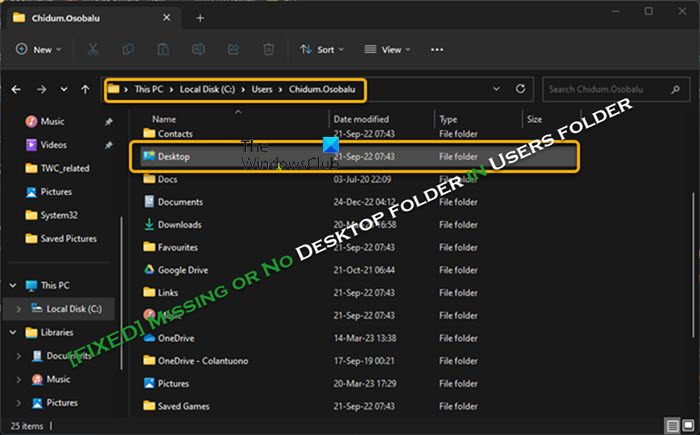
When this issue occurs, you are most likely to be unable to save files on the Desktop. PC users may encounter this issue due to the following main reasons.
- The folder is hidden.
- Virus/malware infection or attacks.
- Location error is caused by an abrupt or sudden change in the desktop folder location which can make the folder unavailable.
- Windows update issues.
- Folder name conflict.
- You may have signed in with a temporary profile.
- Corrupt user profile.
No Desktop folder in the Users folder in Windows 11/10
The Desktop folder (shell:Desktop) is a component of the user profile used as a unified location for storing personal data. By default, the Desktop folder is a shell folder in the user’s profile (%UserProfile%) used as a default storage location item on your desktop.
If you notice that there is no Desktop folder in the Users folder for a particular user account on Windows 11/10, our suggestions below can help you resolve the issue.
- Initial checklist
- Check for Desktop folder name conflict
- Run the File and Folder Troubleshooter
- Restore the Desktop folder to the default location/path
- Create a new User Account
- Perform System Restore
- Uninstall problematic Windows update
- Reset PC
Let’s see how these suggestions can be applied.
1] Initial checklist
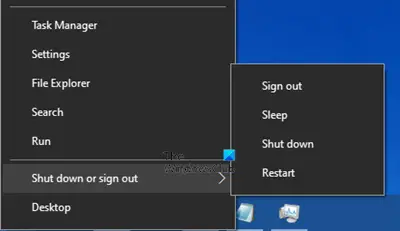
This initial checklist for the issue of missing or no Desktop folder in the Users folder in Windows 11/10 requires you to perform the following tasks and after each, see if the folder has been recovered.
- Restart your PC as it’s likely you are signed in with a temporary profile. This usually happens after a Windows update.
- Run a full system AV scan. Run a full system AV scan with Windows Defender or the third-party AV installed on your system. You can also run any of the free Standalone On demand Antivirus Scanners.
- Run folder/file recovery software. The folder may have been accidentally deleted. So, you can use third-party recovery software that can help PC users recover lost or deleted data from various storage devices.
- Show hidden files and folders. Due to one reason or another, it is also possible the folder has been hidden. So, to rule out this possibility, you can show hidden files/folders on your PC.
Read: Folder and File names are not showing
2] Check for Desktop folder name conflict
If you run through our initial checklist above, the issue persists, then you need to check if there is a Desktop folder name conflict by following the steps below.
- Open File Explorer.
- Navigate to the directory path below. Where the <UserName> placeholder is the user account/profile the Desktop folder is missing.
C:\Users\<UserName>
- At the location, create a new folder and name it Desktop.
- You will now receive the Confirm Folder Replace prompt stating the destination already contains a folder with the same name and if you want to merge them. You will see the current name of the Desktop folder.
- Check if there are two folders with the same name, then locate the real Desktop folder and rename the folder back to Desktop.
- Restart your computer once done.
On boot, see if the missing Desktop folder issue has been resolved. If not, proceed with the next suggested fix.
Read: Location is not available, Access is denied error for files & folders
3] Run the File and Folder Troubleshooter
As the issue is folder-related, you can run the File and Folder Troubleshooter on your Windows 11/10 system and see if that helps. Otherwise, continue with the next fix.
Read: How to remove the User Folders from This PC
4] Restore the Desktop folder to the default location/path
This solution requires you to restore the Desktop folder (also referred to as a Library folder) to its default location/path.
Read: Desktop Location is not available or accessible
5] Create a new User Account
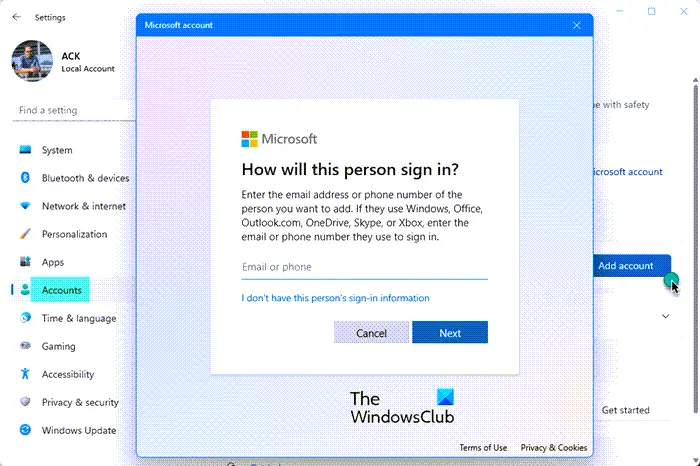
This issue might be a case of a corrupted user profile. In this case, you can attempt to repair the corrupt user profile or create a new user account/profile on your system. This will have all the Library folders by default. However, this might not seem practical as you will need to still access files and folders you have in the Desktop folder on the old user account which you will want to move or transfer to the new user account along with other data. So, you can try the 3rd suggestion in the initial checklist above and see if you can recover any files.
Read: Screen goes Black when I press Alt-Tab in Windows 11
6] Perform System Restore
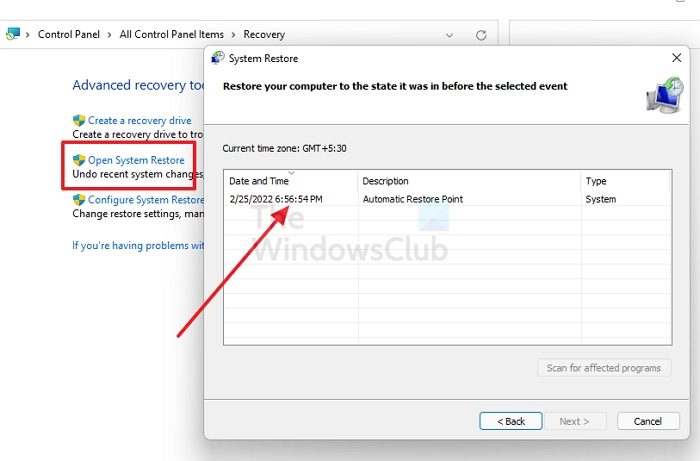
Ideally, system restore does not affect personal files or documents, or folders — but, the Desktop folder is regarded or classified as a system folder. So, this solution requires you to perform System Restore and select a restore point before you noticed the issue. To do this, follow these steps:
- Press the Windows key + R. to invoke the Run dialog.
- In the Run dialog box, type rstrui and hit Enter to launch the System Restore Wizard.
- At the initial screen of System Restore, click Next.
- At the next screen, check the box associated with Show more restore points.
- Now, select a restore point before when you noticed the issue on your device.
- Click Next to advance to the next menu.
- Click Finish and confirm at the final prompt.
At the next system startup, your older computer state will be enforced. The issue should be resolved now. If not, proceed with the next suggestion.
7] Uninstall problematic Windows update

As an alternative to system restores, if you noticed the issue after installing a recent system update, then it might be the culprit. In this case, you can simply uninstall the update and see if that solves your problem.
8] Reset the PC
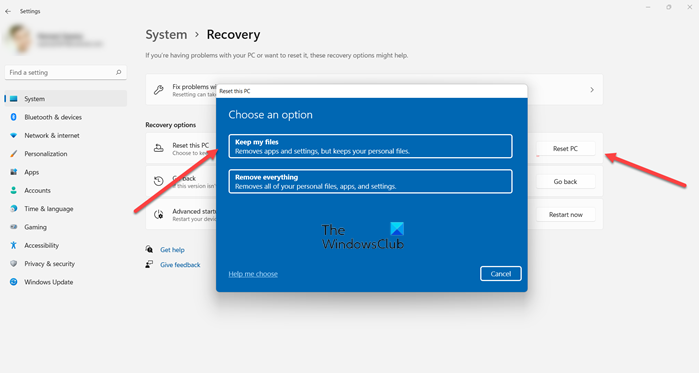
This fix applies in the worst-case scenario whereby in the unlikely event none of the suggestions above was able to restore the Desktop folder. When you reset Windows, the OS is restored to a pristine working state as shipped from the factory with the default settings and apps. Make sure to select the Keep my files option.
Note that the solutions we have offered in this post also apply if any other folder other than the Desktop folder is missing in the Users folder.
Read next: Files and folders suddenly disappeared
Where is the User Desktop Folder in Windows 11?
The known Windows folders viz; Desktop, Documents, Downloads, Pictures, Music, and Videos are all available by default as pinned folders in Quick access in both File Explorer Home and the left navigation pane in newer versions of Windows. The desktop folder for all Users which is also the Public desktop folder is normally hidden. The C:\Users\Public\Desktop file-system directory contains files and folders that appear on the desktop for all users.
How do I fix the desktop icons that disappeared in Windows 11?
If your desktop icons disappeared on your Windows 11/10 PC, it’s most likely the icons are hidden. In this case, you can show or hide desktop icons with a couple of clicks – simply right-click anywhere on an empty spot on your desktop and select View > Show desktop icons to display all your hidden desktop icons. To make a User folder appear on the desktop, open Settings, click Personalization > Themes > Desktop icons settings link, and then click to select each icon you want to see on the desktop.